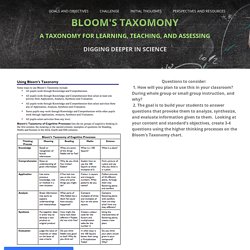

Bloom's Taxonomy - Leveled Questioning. Questions to consider: 1.

How will you plan to use this in your classroom? During whole group or small group instruction, and why? 2. The goal is to build your students to answer questions that provoke them to analyze, synthesize, and evaluate information given to them. Looking at your content and standard's objectives, create 3-4 questions using the higher thinking processes on the Bloom's Taxonomy chart. (n.d.). Room 814. Bloom’s taxonomy is a classification system used to define and distinguish different levels of human cognition—i.e., thinking, learning, and understanding.
Bloom's Taxonomy and Common Core(Click on the title above)Bloom's Taxonomy. Bloom's Taxonomy according to Andy Griffith. The Best Resources For Helping Teachers Use Bloom's Taxonomy In The Classroom. (2009, May 25). Revised Bloom's Taxonomy according to Homer Simpson. Application in Science, Math, Language Arts, and Social Studies science Math. Bloom's Taxonomy - Leveled Questioning. 25 Question Stems Framed Around Bloom's Taxonomy. 25 Question Stems Framed Around Bloom’s Taxonomy by TeachThought Staff While critical thinking is a foundation rather than a brick, how you build that foundation depends on the learning process itself: exposing students to new thinking and promoting interaction with that thinking in a gradual release of responsibility approach.

Question stems can be a powerful part of that process no matter where the learner is. Assessment (pre-assessment, self-assessment, formative and summative assessment), prompting and cueing during discussion, etc. See also 28 Critical Thinking Question Stems & Response Cards ($2.95) 50+ Storytelling Ideas. I’ve always loved being drawn into a great book.

I also enjoy writing and creating stories myself. My son (age 2.5) is at the perfect stage for storytelling. He walks around with his cars, stuffed animals, and other toys setting scenes and talking about their actions. Whether he’s retelling events that have happened to him in real life or making up fantastically improbable stories, he is practicing language skills, and his imagination is hard at work. I’ve collected 65 storytelling ideas from around the web.
Start Here When looking for storytelling telling ideas, I believe the best place to start is at A Mom With A Lesson Plan. Teach storytelling to your kids by writing love stories. Learn how to make storytelling cards {how to have your kids make them}. Learn how to use storytelling cards {once the cards are made, here are tips for using them}. Basic Storytelling for Toddlers – this is my favorite post – learn how to tell stories about your little ones. Story Bags Story Stones Set the Stage. English exercises online: grammar, listening, reading... Launch of the NILE A-Z Activity Cards. Launch of NILE activity cards!

At IATEFL Brimingham we proudly launched a set of 26 alphabetical activity cards.. Each card focuses on one of the NILE trainers’ favourite activities and sets out the intended level and language focus of the activity, plus aims and a detailed procedure. The colour-coded A-Z set of cards covers Speaking (blue) , Reading & Listening (magenta) , Writing (orange), Vocabulary & Grammar (silver) and Pronunciation (purple).
Some of the cards were available on the NILE stand at IATEFL, while others were available at presentations by NILE trainers. During IATEFL you could try to collect as many of the cards as you can; now all are available on our website, which you can access via the QR code on an activity card. Verb-Adverb Charades. Subjects Arts & Humanities --Language Arts --Theater Arts Grade [facebookbadge] Brief Description Verbs and adverbs take center stage in this lively activity.

Objectives Students will silently act out a variety of verbs and adverbs. Keywords verb, adverb, grammar, pantomime, drama, acting, theater Materials Needed [shopmaterials] Teaching Ideas. How Evil Are You? Heartbreak. Six activities new teachers should have up their sleeve. This week I’m joined by Emma Foers.

Emma got in touch with me about doing a post for new teachers. I took a look through the past posts I had done and found that actually I had very little by way of “tried and true” activities for newcomers. So I was happy to accommodate her here. There are many things that can go wrong in a TEFL class – too few students turn up, equipment doesn’t work, students aren’t in the mood, or some students finish activities before others and start to disrupt everyone else, to name just a few of the possible problems!
So it’s always good to have some back-up activities, especially if you’re just starting out. 1) Vocabulary revision games If some students have finished an exercise before the others, you can challenge them to write down 10 items of vocabulary from a previous session (colours, days of the week, household objects). 2) Picture Flashcards Great again to revise past vocabulary in games! 6) Ball game Having a ball in the class entails endless games!